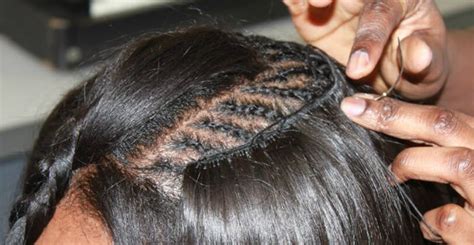Transform your hair game with the allure of sew-in extensions, a technique that seamlessly integrates synthetic or human hair with your natural tresses. This guide will empower you with all the knowledge and practical steps to achieve the perfect sew-in hairstyle that complements your style and elevates your confidence.

Choosing the Right Hair for Sew In
1. Material:
* Synthetic: Economical, durable, and available in various colors and textures.
* Human Hair: More expensive but provides a natural look, can be styled with heat, and lasts longer.
2. Texture:
* Consider your natural hair texture to match or create contrast.
* Options include: straight, wavy, curly, kinky, and coily.
3. Length and Volume:
* Determine the desired length and volume, keeping in mind that longer and thicker hair requires more maintenance.
* Consult with a professional stylist for personalized recommendations.
Step-by-Step Approach to Sew-In Extensions
1. Preparation:
* Wash and deep condition your natural hair to remove any debris or buildup.
* Braid or cornrow your hair into a foundation for the extensions.
2. Measuring and Cutting:
* Measure the width and length of the extensions required for your desired coverage and fullness.
* Cut the hair into sections that match the braids or cornrows.
3. Applying the Extensions:
* Using a curved needle and thread, carefully sew the hair sections onto the braids or cornrows.
* Ensure the sew-in is tight but not too constricting.
4. Blending and Styling:
* Blend the extensions with your natural hair using a brush or comb.
* Style the extensions as desired using heat tools or products.
Why Sew-In Extensions Matter
1. Hair Length and Volume:
* Instantly achieve the desired hair length and volume, enhancing your overall appearance.
2. Styling Versatility:
* Explore endless styling possibilities like braids, ponytails, buns, and updos.
* Heat styling can create volume, texture, or curl patterns.
3. Hair Protection:
* Sew-in extensions protect your natural hair from breakage and damage caused by excessive heat or styling.
Benefits of Sew-In Extensions
1. Low Maintenance:
* Requires less frequent maintenance than other extensions like tape-ins or clip-ins.
* Touch-ups are generally needed every 6-8 weeks.
2. Non-Damaging:
* Unlike other extension methods, sew-ins do not involve heat or glue, minimizing damage to natural hair.
3. Customizable:
* The length, volume, and texture can be tailored to your specific preferences and hair goals.
Engaging with Customers
1. Ask Questions:
* “What are your hair goals and desired results?”
* “Which hair material and texture would complement your lifestyle and style?”
2. Provide Personalized Advice:
* “Based on your hair type and concerns, I recommend using _ hair for your sew-in extension.”
* “To achieve the desired volume, we can add ___ additional hair sections.”
3. Address Concerns:
* “Sew-in extensions are a non-damaging method that can protect your natural hair from breakage.”
* “Touch-ups are relatively infrequent, requiring attention every 6-8 weeks.”
Table 1: Comparison of Hair Materials for Sew-In Extensions
| Material | Pros | Cons |
|---|---|---|
| Synthetic | Affordable, durable, wide color selection | Less natural-looking, less heat-resistant |
| Human Hair | Natural-looking, heat-resistant, can be colored | More expensive, requires more maintenance |
Table 2: Popular Textures for Sew-In Extensions
| Texture | Features | Benefits |
|---|---|---|
| Straight | Easy to style, versatile | Sleek and elegant look |
| Wavy | Adds volume and movement | Soft and romantic style |
| Curly | Creates volume and definition | Defined curls and body |
| Kinky | Tight curls, adds texture | Afros and natural styles |
| Coily | Dense curls, voluminous | Creates a full and textured look |
Table 3: Preparation for Sew-In Extensions
| Step | Description |
|---|---|
| Hair Preparation | Wash and condition hair to remove buildup. |
| Braiding or Cornrowing | Create a foundation for the extensions using braids or cornrows. |
| Measurement | Determine the length and volume of hair needed based on desired coverage. |
| Cutting | Cut the hair sections into sizes that match the braids or cornrows. |
Table 4: Sew-In Extension Application
| Step | Description |
|---|---|
| Sewing | Sew the hair sections onto the braids or cornrows using a curved needle and thread. |
| Blending | Brush or comb the extensions to blend with natural hair. |
| Styling | Style the extensions as desired using heat tools or products. |
In conclusion, hair for sew in can transform your look and enhance your hair game. By following the comprehensive guide outlined above, you can create a customized sew-in hairstyle that aligns with your style and hair goals. Seek professional assistance when necessary and embrace the benefits of sew-in extensions to achieve long-lasting, damage-free, and stylish hair.
